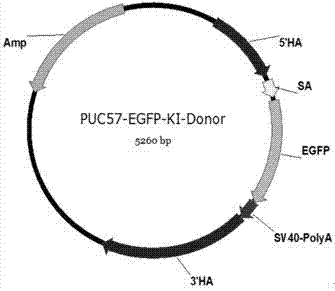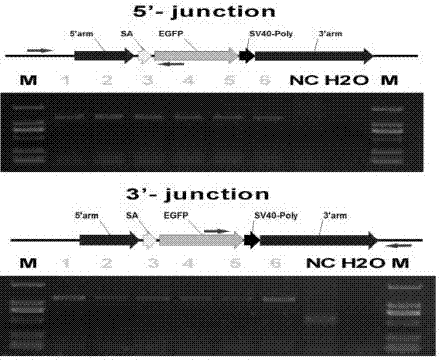Single guide ribonucleic acid (sgRNA) capable of effectively editing pig ROSA26 gene, and application of sgRNA
An editing and gene technology, applied in DNA/RNA fragments, recombinant DNA technology, animal husbandry, etc., can solve problems such as limiting the breeding and application prospects of transgenic pigs
- Summary
- Abstract
- Description
- Claims
- Application Information
AI Technical Summary
Problems solved by technology
Method used
Image
Examples
Embodiment 1
[0024] 1-1. Design of sgRNA sequence and construction of PX330 expression vector
[0025] Three sgRNA sequences targeting porcine ROSA26 locus were designed and synthesized. The shRNA sequence designed above was synthesized; the DNA sequences of the six single-stranded sgRNAs were annealed respectively to form three oligonucleotide chains targeting sgRNAs at different positions in the first intron of porcine ROSA26; and then the oligonucleotides were polymerized Nucleotides were ligated into the PX330 plasmid vector.
[0026] The sequences of the three sgRNAs and the sequences of their action sites are:
[0027] SgRNA-86 sequence: 5-ATCGCAGTGGTAGTCAAGAT-3;
[0028] The sequence of the sgRNA-86 action site: 5-ATCTTGACTACCACTGCGAT-3;
[0029] SgRNA-89 sequence: 5-ATCTTGAGCATAGGCCCAAC-3;
[0030] The sequence of the sgRNA-89 action site: 5-GTTGGGCCTATGCTCAAGAT-3;
[0031] SgRNA-91 sequence: 5-TACGGTCAGATAACTCTCAC-3;
[0032] The sequence of the sgRNA-91 action site: 5-GTGAG...
Embodiment 2
[0042] Construction of targeting vector for site-specific integration of EGFP
[0043] According to the screened high-efficiency sgRNA, design and construct the EGFP gene targeting vector (PUC57-EGFP-KI-Donor) matching the sgRNA. The main components of the targeting vector are: upstream homology arm, SA site, EGFP gene, PolyA sites, downstream homology arms, and backbone vectors for prokaryotic expression. The EGFP site-specific integration targeting plasmid and the screened sgRNA can specifically genetically modify the ROSA26 site of the pig genome, and then combine the method of fluorescence microscopy and PCR to easily analyze the foreign gene at the sgRNA recognition site Feasibility of integration and expression. figure 2 It is a schematic diagram of the EGFP targeted targeting plasmid vector of the present invention.
Embodiment 3
[0045] (1) Co-transfection of PX330 plasmid and PUC57-EGFP-KI-Donor plasmid
[0046] Resuscitate the fetal fibroblasts of the primary pigs, and when they are transferred to the F3 generation, digest the fetal fibroblasts of the F3 pigs, wash with DPBS 2 to 3 times, discard the supernatant, add electrotransfection buffer, and then PX330 Add the plasmid and the PUC57-EGFP-KI-Donor plasmid to the cells and the buffer in proportion, mix gently with a pipette, then gently transfer the mixture into the electrode cup, and place the electrode cup on the electroporation instrument Perform electric shock operation. After the electric shock was completed, the electrode cup was left to stand at 4° C. for 10 minutes, and then the mixture in the electrode cup was transferred to a cell culture dish. Finally, the cell culture dish was placed in a 39°C carbon dioxide incubator for cultivation. After 12 hours of incubation, the medium was changed.
PUM
 Login to View More
Login to View More Abstract
Description
Claims
Application Information
 Login to View More
Login to View More - R&D
- Intellectual Property
- Life Sciences
- Materials
- Tech Scout
- Unparalleled Data Quality
- Higher Quality Content
- 60% Fewer Hallucinations
Browse by: Latest US Patents, China's latest patents, Technical Efficacy Thesaurus, Application Domain, Technology Topic, Popular Technical Reports.
© 2025 PatSnap. All rights reserved.Legal|Privacy policy|Modern Slavery Act Transparency Statement|Sitemap|About US| Contact US: help@patsnap.com



